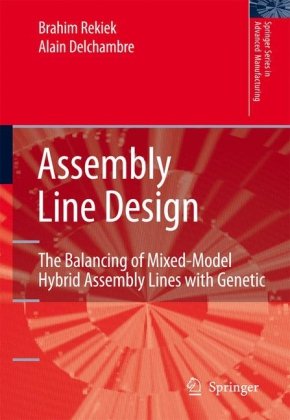

Most ebook files are in PDF format, so you can easily read them using various software such as Foxit Reader or directly on the Google Chrome browser.
Some ebook files are released by publishers in other formats such as .awz, .mobi, .epub, .fb2, etc. You may need to install specific software to read these formats on mobile/PC, such as Calibre.
Please read the tutorial at this link: https://ebookbell.com/faq
We offer FREE conversion to the popular formats you request; however, this may take some time. Therefore, right after payment, please email us, and we will try to provide the service as quickly as possible.
For some exceptional file formats or broken links (if any), please refrain from opening any disputes. Instead, email us first, and we will try to assist within a maximum of 6 hours.
EbookBell Team

4.4
82 reviews
ISBN 10: 1846281121
ISBN 13: 9781846281129
Author: Brahim Rekiek, Alain Delchambre
Efficient assembly line design is a problem of industrial importance. Assembly line design is often complex due to the multiple components involved: efficiency, cost and space. The aim is to integrate the design with operations issues, minimising costs. It is important to give the designer tools to help him meet the different objectives. 3 techniques based on the Grouping Genetic Algorithm are presented which can be used to aid assembly line design: - ‘equal piles for assembly lines’ deals with assembly line balancing (balancing stations’ loads); - a method based on a multiple objective grouping genetic algorithm (MO-GGA) deals with resource planning (selection of equipment); - ‘balance for operation’, deals with the changes during the operation of assembly lines. This book will interest technical personnel in design, planning and production departments in industry as well as managers in industry. It will also be of use to researchers and postgraduates in mechanical, manufacturing or micro-engineering.
1 Front Matter
2 Assembly Line Design Problems
3 Designing Assembly Lines
4 Design Approaches
5 Assembly Line: History and Formulation
6 Evolutionary Combinatorial Optimisation
7 Multiple Objective Grouping Genetic Algorithm
8 Assembly Line Layout
9 Equal Piles for Assembly Line Balancing
10 The Resource Planning for Assembly Line
11 Balance for Operation
12 The Integrated Method
13 Evolving to Integrate Logical and Physical Layout of Assembly Lines
14 Concurrent Approach to Design Assembly Lines
15 A Real-world Example Optimised by the OptiLine Software
16 Conclusions and Future Work
17 Back Matter
Tags: Brahim Rekiek, Alain Delchambre, Assembly, Design